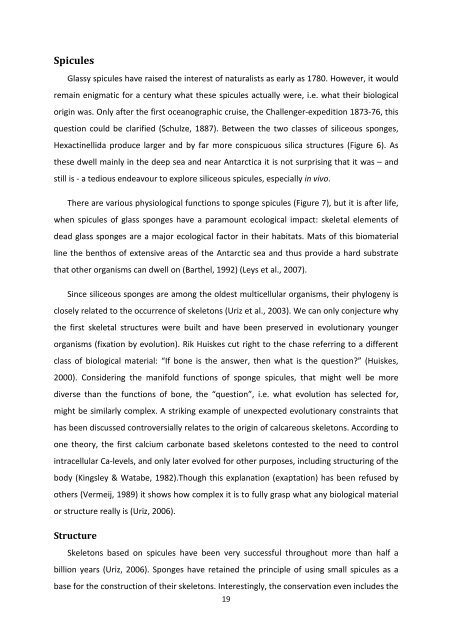MASTER THESIS Biomimetic potential of sponge ... - IAP/TU Wien
MASTER THESIS Biomimetic potential of sponge ... - IAP/TU Wien
MASTER THESIS Biomimetic potential of sponge ... - IAP/TU Wien
You also want an ePaper? Increase the reach of your titles
YUMPU automatically turns print PDFs into web optimized ePapers that Google loves.
Spicules<br />
Glassy spicules have raised the interest <strong>of</strong> naturalists as early as 1780. However, it would<br />
remain enigmatic for a century what these spicules actually were, i.e. what their biological<br />
origin was. Only after the first oceanographic cruise, the Challenger-expedition 1873-76, this<br />
question could be clarified (Schulze, 1887). Between the two classes <strong>of</strong> siliceous <strong>sponge</strong>s,<br />
Hexactinellida produce larger and by far more conspicuous silica structures (Figure 6). As<br />
these dwell mainly in the deep sea and near Antarctica it is not surprising that it was – and<br />
still is - a tedious endeavour to explore siliceous spicules, especially in vivo.<br />
There are various physiological functions to <strong>sponge</strong> spicules (Figure 7), but it is after life,<br />
when spicules <strong>of</strong> glass <strong>sponge</strong>s have a paramount ecological impact: skeletal elements <strong>of</strong><br />
dead glass <strong>sponge</strong>s are a major ecological factor in their habitats. Mats <strong>of</strong> this biomaterial<br />
line the benthos <strong>of</strong> extensive areas <strong>of</strong> the Antarctic sea and thus provide a hard substrate<br />
that other organisms can dwell on (Barthel, 1992) (Leys et al., 2007).<br />
Since siliceous <strong>sponge</strong>s are among the oldest multicellular organisms, their phylogeny is<br />
closely related to the occurrence <strong>of</strong> skeletons (Uriz et al., 2003). We can only conjecture why<br />
the first skeletal structures were built and have been preserved in evolutionary younger<br />
organisms (fixation by evolution). Rik Huiskes cut right to the chase referring to a different<br />
class <strong>of</strong> biological material: “If bone is the answer, then what is the question?” (Huiskes,<br />
2000). Considering the manifold functions <strong>of</strong> <strong>sponge</strong> spicules, that might well be more<br />
diverse than the functions <strong>of</strong> bone, the “question”, i.e. what evolution has selected for,<br />
might be similarly complex. A striking example <strong>of</strong> unexpected evolutionary constraints that<br />
has been discussed controversially relates to the origin <strong>of</strong> calcareous skeletons. According to<br />
one theory, the first calcium carbonate based skeletons contested to the need to control<br />
intracellular Ca-levels, and only later evolved for other purposes, including structuring <strong>of</strong> the<br />
body (Kingsley & Watabe, 1982).Though this explanation (exaptation) has been refused by<br />
others (Vermeij, 1989) it shows how complex it is to fully grasp what any biological material<br />
or structure really is (Uriz, 2006).<br />
Structure<br />
Skeletons based on spicules have been very successful throughout more than half a<br />
billion years (Uriz, 2006). Sponges have retained the principle <strong>of</strong> using small spicules as a<br />
base for the construction <strong>of</strong> their skeletons. Interestingly, the conservation even includes the<br />
19

















